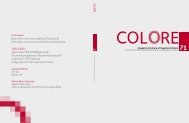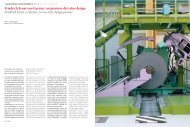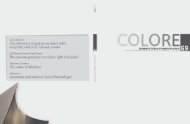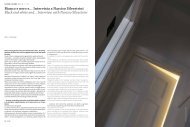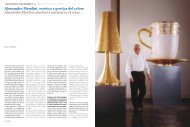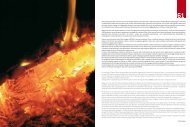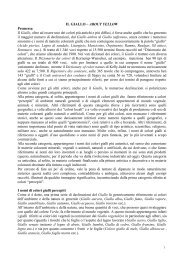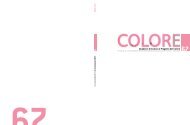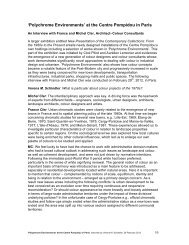Quaderni di Cultura e Progetto del Colore - Istituto Del Colore
Quaderni di Cultura e Progetto del Colore - Istituto Del Colore
Quaderni di Cultura e Progetto del Colore - Istituto Del Colore
Create successful ePaper yourself
Turn your PDF publications into a flip-book with our unique Google optimized e-Paper software.
CULTURA / CULTURE [ 1 2 (3 + 4) 5 6 ]<br />
da 18 colori, il Marrone non esiste.<br />
I riferimenti dei colori “Marrone” sono <strong>di</strong> vario tipo, come avviene per tutti<br />
i colori. Un riferimento d’obbligo è naturalmente quello relativo al mondo<br />
vegetale (Marrone o Castagna, Castagna d’In<strong>di</strong>a, Marroncino bosco<br />
ecc.). Un altro riferimento è quello <strong>di</strong>retto o in<strong>di</strong>retto al regno animale<br />
(Marron pulce, Marrone fegato, Marrone osso ecc.), al mondo industriale<br />
(Marrone Fiat, Marrone Ral ecc.), al regno minerale (Marrone <strong>di</strong> rame,<br />
Marrone dorato, Marrone zolfo, Ocra marrone ecc.). Un altro riferimento,<br />
ancora, è quello storico (Marrone azteco, Marrone Bismark ecc.) e quello<br />
geografico (Marrone francese, Marrone fiorentino, Marrone in<strong>di</strong>ano,<br />
Marrone Avana, ecc.). Non mancano i riferimenti alla moda (“Marrone<br />
dei tinturieri” ecc.), all’arte (le velature “marronastre” <strong>di</strong> Rembrandt, il<br />
“marrone–rosato chiaro” <strong>di</strong> Vermeer ecc.) e alla gastronomia (Marrone<br />
castagna, Marrone arrostito, Marrone cioccolata/o Marron glacé, Marrone<br />
moka ecc), a oggetti <strong>di</strong> uso quoti<strong>di</strong>ano (Marrone scuro bagagli). Di<br />
tutti i riferimenti, i nomi marroni <strong>di</strong> fantasia sono numerosi, ma anche<br />
piuttosto improbabili (Marrone calypso, Marrone conchiglia ecc.).<br />
Mentre per molti altri colori comuni, si trovano materie coloranti da cui<br />
derivano in modo naturale e più o meno <strong>di</strong>retto, sin dall’antichità, a<br />
parte la “Lacca <strong>di</strong> robbia marrone” <strong>di</strong> George Field, il “Marrone <strong>di</strong> Hay” e<br />
pochi altri, per il “Marrone”, che deriva dall’ossido <strong>di</strong> manganese, bisogna<br />
aspettare l’era moderna, con i colori organici derivati dal catrame<br />
(Marrone zolfo, Marrone d’anilina, Marrone imme<strong>di</strong>ato ecc.).<br />
Al solito, anche per un colore poco eccitante come il Marrone, il fattore<br />
moltiplicatore è dato dalle sue ovvie declinazioni (Marrone chiaro,<br />
Marrone caldo, Marrone carico, Marrone carico tirante al violetto, Marrone<br />
cupo ecc.), dalle sue associazioni con altri nomi <strong>di</strong> colori (Marrone<br />
arancio, Bruno marrone, Giallo marrone, Rosa marrone, Grigio marrone,<br />
Marrone verdastro ecc.) o dalla combinazione dei due (Marrone rossiccio<br />
chiaro, Porpora marrone scuro ecc.). Partito come un colore oggettivamente<br />
poco menzionato nei <strong>di</strong>zionari dei colori, classici, grazie alle<br />
sue declinazioni e all’apertura ai nomi <strong>di</strong> fantasia, il marrone finisce per<br />
moltiplicarsi come avviene in genere per tutti i colori, pur rimanendo<br />
decisamente un colore poco eccitante, anche se a tutti piacciono i Marron<br />
glacé o la cioccolata e ammirano Rembrandt….<br />
Castaneus (Castaneous).<br />
Per il Répertoire des couleurs, il marrone è la riproduzione <strong>del</strong> Castaneus<br />
<strong>del</strong> Professor Saccardo. Per Kelly-Judd, Castaneous è sinonimo<br />
sia <strong>di</strong> “Castagna” (Chestnut), che <strong>di</strong> “Marrone” (Maroon). La sua traduzione<br />
in italiano potrebbe essere “Castagnino”.<br />
Notazioni: Munsell: 9.0R 3.4/2.4 - NCS: S 7010-Y30R.<br />
Denominazioni ISCC.NBS: 43 – Bruno rossiccio grigiastro (grayish red<strong>di</strong>sh<br />
Brown).<br />
Marron glacé (Marron glacé).<br />
Kelly-Judd assimilano il Marron glacé (“Marrone can<strong>di</strong>to”) ad un colore<br />
bruno me<strong>di</strong>o.<br />
Notazioni: Munsell: 5.6YR 3.5/3.9 - NCS: S 7020-Y60R.<br />
Denominazioni ISCC.NBS: 59 – Bruno me<strong>di</strong>o (moderate Brown).<br />
Marrone (Maroon).<br />
Marrone è il colore <strong>del</strong>le castagne nella loro fase <strong>di</strong> maturità, ma è an-<br />
One reference is naturally that of plant kingdom (Chestnut Maroon, In<strong>di</strong>an<br />
Chestnut, Light Wood Maroon etc.) Others are <strong>di</strong>rectly or in<strong>di</strong>rectly<br />
related to the animal world (Flea Maroon, Liver Maroon, Bone Maroon<br />
etc.), to industry (Fiat Maroon, Rai Maroon etc.), to minerals (Copper<br />
Maroon, Golden Maroon, Brimstone Maroon, Ochre Maroon etc.). Another<br />
reference, then, is related to history (Aztec Maroon, Bismark Maroon<br />
etc.) and to geography (French Maroon, Florence Maroon, In<strong>di</strong>an<br />
Maroon, Havana Maroon etc.). References to fashion are also present<br />
(“Dyers Maroon” etc.) as well as to art (Rembrandt’s light “maroon”<br />
glosses, Vermeer’s “light pinkish maroon” etc.) and to gastronomy<br />
(Chestnut Maroon, Roast Maroon, Chocolate Maroon, Marron Glacé,<br />
Mocha Maroon etc.) or to everyday objects (Luggage Dark Maroon).<br />
Among all references, fantasy names are common, even the most unlikely<br />
ones (Calypso Maroon, Shell Maroon etc.).<br />
While for many other common colours, there are colouring materials<br />
from which they naturally derive in a more or less <strong>di</strong>rect way, since<br />
ancient times, and exclu<strong>di</strong>ng George Field’s “Common Madder Lacquer”,<br />
“Hay’s Maroon” and few others, for “Maroon”, that is obtained<br />
from manganese oxide, we have to wait until the modern era, when tar<br />
derived organic colours became available (Brimstone Maroon, Aniline<br />
Maroon, Ready Made Maroon etc.).<br />
As usual, even for a not so exciting colour such as Maroon, the multiplying<br />
element comes from its many variations (Light Maroon, Warm<br />
Maroon, Intense Maroon, Nearly Purple Intense Maroon, Deep Maroon<br />
etc.), its connection with other colour names (Orange Maroon, Brown<br />
Maroon, Yellow Maroon, Rose Maroon, Grey Maroon, Greenish Maroon<br />
etc) or colour combinations (Light Red<strong>di</strong>sh Maroon, Dark Purple Maroon<br />
etc.). Started as a colour undoubtedly not much mentioned in<br />
<strong>di</strong>ctionaries of colour, at least classical ones, thanks to its many variations<br />
and to the possibility of fantasy names, maroon spreads as it<br />
happen for any other colour, thus remaining an unexciting colour, even<br />
though everybody likes Marron glacés or chocolate and appreciates<br />
Rembrandt.<br />
Castaneus<br />
Accor<strong>di</strong>ng to Répertoire des couleurs, maroon is the equivalent of Professor<br />
Saccardo’s Castaneus.<br />
For Kelly-Judd Castaneus is synonym of Chestnut as well as Maroon. In<br />
Italian it could be called “Castagnino”.<br />
Munsell Notation: 9.0R 3.4/2.4 – NCS Notation: S 7010-Y30R.<br />
ISCC.NBS designation: 43 - Grey Red<strong>di</strong>sh Brown<br />
Marron Glacé<br />
Kelly-Judd relates Marron Glacé (“Can<strong>di</strong>ed Chestnut”) to moderate<br />
brown.<br />
Munsell Notation: 5.6YR 3.5/3.9 - NCS Notation: S 7020-Y60R.<br />
ISCC.NBS designation: 59 - Moderate Brown<br />
Maroon<br />
“Maroon” is the colour of chestnuts when ripe, but is also the colour of<br />
certain woods (rose, pear etc.) or mushrooms, among them Boletus.<br />
It is the reproduction of Professor Saccardo’s Castaneus, Philip Ball<br />
calls it a “<strong>di</strong>rty colour”, a “yellow or orange with scarce brightness”, not<br />
che la colorazione <strong>di</strong> certi legni (legni <strong>di</strong> rosa, <strong>di</strong> pera ecc.) o <strong>di</strong> certi<br />
funghi, tra cui il Boletus. Esso costituisce la riproduzione <strong>del</strong> Castaneus<br />
<strong>del</strong> professor Saccardo, Philip Ball, lo definisce un “colore sporco”, “un<br />
giallo o un arancio con poca luminosità”, che non figura nel <strong>di</strong>agramma<br />
CIE. I sinonimi più vicini – “Castagna” e “Castagno” - sono ritenuti impropri<br />
dal Répertoire des couleurs.<br />
Notazioni: Munsell: 9.0R 3.4/2.4; 5.5YR 3.5/1.8 - NCS: S 7010-Y30R; S<br />
7010-Y70R .<br />
Denominazioni ISCC.NBS: 43 – Bruno rossiccio grigiastro (grayish red<strong>di</strong>sh<br />
Brown); 61 – Bruno grigiastro (grayish brown).<br />
Marrone azteco (Aztec maroon).<br />
“Marrone azteco” è definito da Kelly-Judd come colore “Rosso purpureo<br />
grigiastro“.<br />
Notazione: Munsell: 7.0R 4.5/5.1 - NCS: S 5020-R20B .<br />
Denominazione ISCC.NBS: 262 – Rosso purpureo grigiastro (grayish<br />
purplish Red).<br />
Marrone cioccolata/o (Chocolate maroon).<br />
“Marrone cioccolata” è il colore <strong>del</strong>la cioccolata ottenuta dal puro cacao<br />
senza latte, Secondo Kelly-Judd, questo colore è sinonimo <strong>di</strong> “Foglia <strong>di</strong><br />
rosa vecchia”.<br />
Notazione: Munsell: 4.0R 2.8/6.8 - NCS: S 5030-R.<br />
Denominazione ISCC.NBS: 16 – Rosso scuro (dark Red).<br />
Marrone <strong>di</strong> Hay (Hay’s maroon).<br />
“Marrone <strong>di</strong> Hay” un colore marrone intenso.<br />
Notazione: Munsell: 2.9R 2.7/2.1 - NCS: S 7010-R10B.<br />
Denominazione ISCC.NBS: 20 – Rosso grigiastro scuro (dark grayish Red).<br />
Marrone fegato (Liver maroon).<br />
Il “Marrone fegato” è un colore rosso bruno, sinonimo <strong>di</strong> “Bruno fegato”.<br />
Notazioni: Munsell: 9.0R 3.4/2.4; 9.0R 3.4/5.2; NCS: S 7010-Y90R; S<br />
6020-Y90R.<br />
Denominazioni ISCC.NBS: 43 – Bruno rossastro me<strong>di</strong>o (moderate red<strong>di</strong>sh<br />
Brown); 46 – Bruno rossastro grigiastro<br />
(grayish red<strong>di</strong>sh Brown).<br />
Marrone francese (French maroon)<br />
“Marrone francese” è sinonimo <strong>di</strong> “Marrone fegato”,<br />
Notazione: Munsell: 9.0R 3.4/2.4; NCS: S 7010-Y90R.<br />
Denominazione ISCC.NBS: 19 – Bruno rossastro grigiastro (grayish<br />
red<strong>di</strong>sh Brown).<br />
Marrone intenso (Deep maroon).<br />
Il “Marrone intenso” è assimilato da Kelly-Judd al “Marrone <strong>di</strong> Hay”.<br />
Notazione: Munsell: 2.9R 2.7/2.1 - NCS: S 7010-R10B.<br />
Denominazione ISCC.NBS: 20 – Rosso grigiastro scuro (dark grayish Red).<br />
Porpora marrone scuro (Dark maroon purple).<br />
Notazione: Munsell: 1.3RP 2.8/4.8; NCS: S 6020-R90B.<br />
Denominazione ISCC.NBS: 242 – Porpora rossastra scura (dark red<strong>di</strong>sh<br />
Purple).<br />
...selezione dai marroni / ...maroon selection<br />
figuring in the CIE <strong>di</strong>agram. The closest synonyms are “Chestnut” or<br />
“Chestnut Tree”, even though Répertoire des couleurs considers them<br />
as inappropriate.<br />
Munsell Notation: 9.0R 3.4/2.4; 5.5YR 3.5/1.8 - NCS Notation: S<br />
7010-Y30R; S7010 Y70R<br />
ISCC.NBS designation: 43 - Greyish Red<strong>di</strong>sh Brown; 61 – Greyish Brown<br />
Aztec Maroon<br />
Kelly-Judd defines “Aztec Maroon” as Grey Purplish Red.<br />
Munsell Notation: 7.0R 4.5/5.1 - NCS Notation: S 5020-R20B.<br />
ISCC.NBS designation: 262 - Grey Purplish Red<br />
Chocolate Maroon<br />
“Chocolate Maroon” is the colour of pure dark chocolate, made without<br />
milk. Accor<strong>di</strong>ng to Kelly-Judd, this colour is synonym of “Old Rose Leaf”.<br />
Munsell Notation: 4.0R 2.8/6.8 - NCS Notation: S5030-R.<br />
ISCC.NBS designation: 16 - Dark Red<br />
Hay’s Maroon<br />
“Hay’s Maroon” is a deep maroon colour.<br />
Munsell Notation: 2.9R 2.7/2.1 - NCS Notation: S7010-R10B<br />
ISCC.NBS designation: 20 - Dark Greyish Red<br />
Liver Maroon<br />
“Liver Maroon” is a red-brown colour, synonym of “Liver Brown”.<br />
Munsell Notation: 9.0R 3.4/2.4; 9.0R 3.4/5.2 - NCS Notation: S7010-<br />
Y90R; S6020-Y90R.<br />
ISCC.NBS designation: 43 - Grey Red<strong>di</strong>sh Brown; 46 – Greyish Red<strong>di</strong>sh<br />
Brown<br />
French Maroon<br />
“French Maroon” is synonym of “Liver Maroon”.<br />
Munsell Notation: 9.0R 3.4/2.4 - NCS Notation: S 7010-Y90R.<br />
ISCC.NBS designation: 19 – Greyish Red<strong>di</strong>sh Brown<br />
Deep Maroon<br />
“Deep Maroon” is similar, accor<strong>di</strong>ng to Kelly-Judd, to “Hay’s Maroon”.<br />
Munsell Notation: 2.9R 2.7/2.1 - NCS Notation: S 7010-R10B.<br />
ISCC.NBS designation: 20 – Dark Greyish Red<br />
Dark Maroon Purple<br />
Munsell Notation: 1.3RP 2.8/4.8 - NCS Notation: S 6020-R90B<br />
ISCC.NBS designation: 242 – Dark Red<strong>di</strong>sh Purple<br />
50 COLORE<br />
COLORE 51<br />
Alessandro D'Adda, Convolutions



